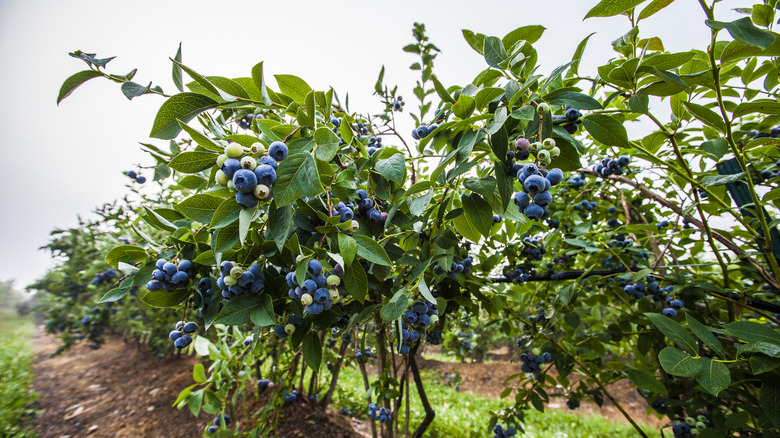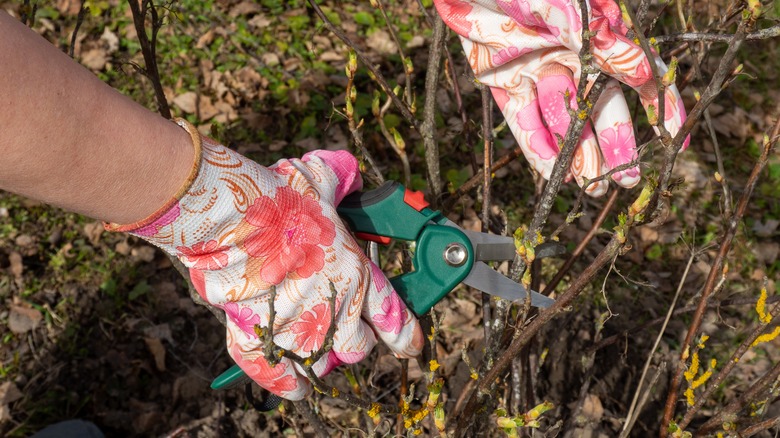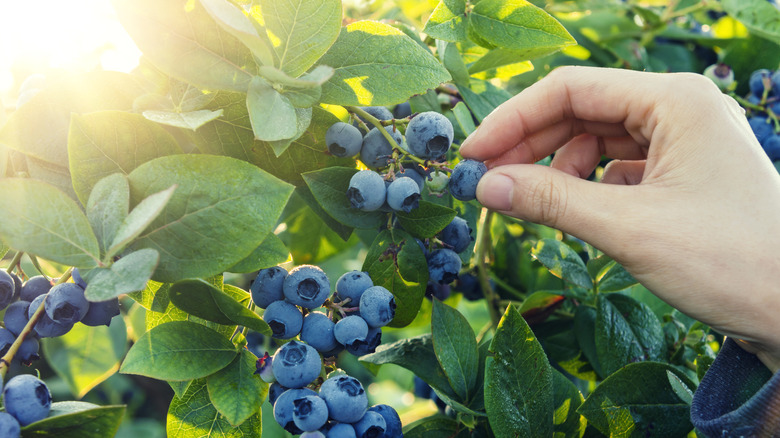The Benefits Of Pruning Your Blueberry Bushes In Summer (& How To Do It)
Gardeners with fruit bushes know that taking care of them can be "berry" rewarding. But before you can taste the sweet victory of a fresh harvest, you have to get through the season. And there are a lot of mistakes you can make with blueberry bushes. That said, deciding to prune them in the summer can be a good or bad thing, depending on how you care for them afterward. Shirley Bovshow of Foodie Gardener exclusively told House Digest that there are many benefits to pruning blueberry bushes in the warmest months to keep the bushes happy.
The award-winning garden designer and type 2 diabetes advocate said that summertime pruning "encourages growth [since] pruning blueberry bushes in the summer promotes new shoot development, which can increase fruit production for the following season." She also explained that doing so reduces the risk of fungal infections because it improves airflow to the plant.
However, there are a few downsides to consider as well. Bovshow explained that summer pruning can actually cause the plant to get sunburned. You may also get a smaller berry harvest. "When over-pruned, the plant might produce fewer berries in the current season," she said. "After pruning, the plant diverts energy to healing and new stem growth rather than producing berries." That's why she advises pruning after the first harvest instead of before. The time for your first blueberry harvest depends on where you live, but typically takes place between June and August.
How to prune the blueberry bushes
As with any garden care, there are pros and cons to how you do it. That's why we asked Shirley Bovshow for her best techniques for blueberry bush pruning. But aside from crucial elements like the important ⅓ pruning rule, what else should gardeners be aware of for summertime pruning? In an exclusive interview with House Digest, she said it should start with the "Triple D" method. "Remove dead, damaged, and diseased wood!" Bovshow advised. "This will improve the plant's health and create a desirable, open structure." She added, "When you don't prune, the blueberry bush is filled with old, damaged, and unproductive canes. This will impact blueberry yield and quality."
She suggests getting rid of crowding center branches to encourage fruiting and help with both air flow and sunlight access. Additionally, Bovshow says to trim canes until they are 6 to 12 inches off the ground and not to take off too many leaves to keep the plant shaded from direct sun — which can lead to sun damage, especially during the summer. "Pruning blueberry bushes promotes optimal health, productivity, and lifespan of the plant," she added.
But if you don't prune your blueberry bush at all, you're risking its overall health and ability to bear fruit, Bovshow explained. She added that is a necessary process to help new canes grow and produce more berries and helps the bush keep its shape to make harvesting easier.
Pruning mistakes to avoid
The process of pruning can sound overly simple. Yet, if you're not careful, the mistakes made while pruning your plants can be detrimental to their health. Shirley Bovshow told House Digest in an exclusive interview that there is a range of negative outcomes to pruning a blueberry bush at the wrong time of year. "Pruning during the late spring/early summer can remove buds that would produce berries later in the season, reducing the current year's harvest," she explained. "Pruning in the fall may stimulate new growth that is susceptible to frost damage." Plus, she added that if you prune when the bushes are wet, it can lead to fungal infections.
Bovshow advises taking care when pruning that you aren't going overboard at any time of year. She says to not prune more than 20 to 25% of the bush in a year because it needs time to recover. You can also cause it to go into shock by pruning too much, as well. To help your blueberry bush stay happy and stress-free in your pruning season, Bovshow suggests a few easy steps to follow. "Apply mulch around the base of the bush and water deeply after pruning to help the plant recover and reduce stress," she said. Another important rule to remember? "Use sharp, clean, sanitized tools to prevent the spread of diseases from plant to plant!" she said.


